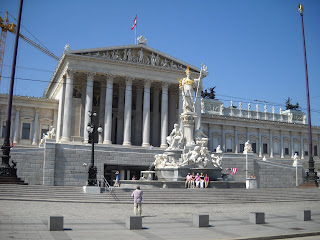The German word of the day is Offen, which translates to "Frank."
Oh Biedermier. You bore me. I don't mean to be rude, but you just don't do it for me. On a scale of 1-10 you are hovering around a 5.6835. You remind me of jellybeans: Pretty on the outside, but once you have too much your stomach starts to ache.
The Biedermier phenomenon that took place from 1815-1848 was an attempt to emulate the nobility by the middle-class. It was originally a term to describe a style of furniture but was quickly changed into "a way of life". Aaron Green, a writer and music enthusiast, says that the cause of the Biedermier period was the end of the French Revolution and the monarchies of Europe trying to keep a grasp of the situation. To make sure there was no a repeat of violence, "monarchies of Europe reigned with steel-fisted precision and secret intelligence agencies." People were "forced out of the coffee houses and into their homes" as different social organizations like lodges and clubs were shut down. Because the world outside is so dangerous, the home and close friends were the focus of the time period. To me, it looks like pre-1950's Americana. On the other hand, the Biedermier style of the Stadttempel (the main synagogue in Vienna) probably saved it from being destroyed during Kristallnact.
In the Wien Museum there were multiple examples of Biedermier art and style. I like this one in particular because it looks like Jan.

Here are some other examples.



The Biedermier was a stand against the Baroque and Rococo styles of "the past" and a push towards restraint, elegance and comfort.
The more interesting artifact that I found at the Wien Museum would have made followers of the Biedermier style completely uncomfortable. Below is the executioner’s sword of the city along with his robe. The wheel was actually used to roll over people’s bodies for torture and snap bones in half. Ewwwwww...


I also went on the Ringstraße tour today, which was very relaxing. The tour was a yellow tram that traveled along the route where the old wall of the city used to stand. It shows how the buildings inside the original wall have expanded to fit a more "global" purpose while at the same time explaining the urban growth that has taken place in Wien. The buildings along the tour are a clear example of what the Secessionists were againgst, which is historical purpose in architecture. Each individual building has a different architectural style that represents its purpose or function. For example, Parliament is in the Neo-Classical style meant to emulate Greece and the foundations of democracy.

The Kunsthistorisches and Naturhistorisches Museums are in the Renaissance architectural style. During the Renaissance there was a push towards classical study and learning, which is the function of the two museums. (The one below is the Naturhistorisches.)

The Hofburg Palace might be Neo-Baroque to represent the Absolutism and excess of the monarchy, but I particularly enjoy the older Renaissance courtyard next to the treasury.


I personally prefer the architecture to be in historical style and function rather than follow the ideals of the Secessionists. Maybe that is the history major in me, but I like to see a nations history in its buildings. I understand paintings a little more and do not mind them not having historical context, although I do not believe the latter of the two should be done away with completely. I personally like Klimt to a certain degree. He is not my favorite artist in the world, and this is going to piss Kathy off, but I actually enjoy Scheele more. I do, however, recognize any group that is trying to make a movement or statement in the art world like the Secessionists were. Below is the Secession Hall in Wien where the art of Secessionists like Klimt, Schiele, Moser and Fabiani can be found today.


No comments:
Post a Comment